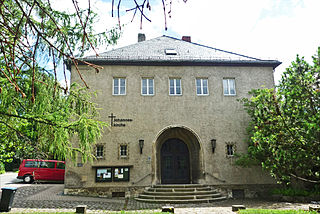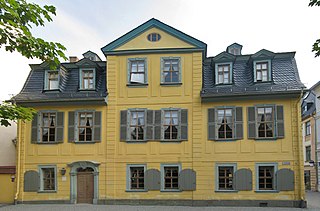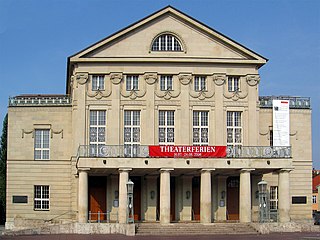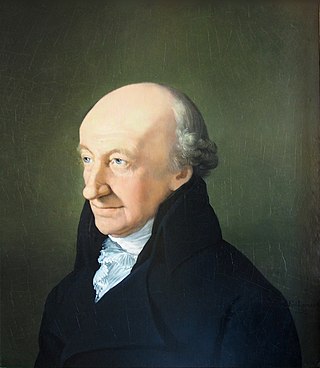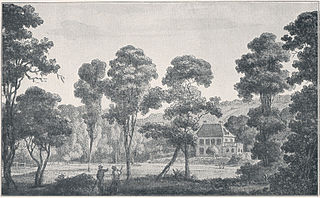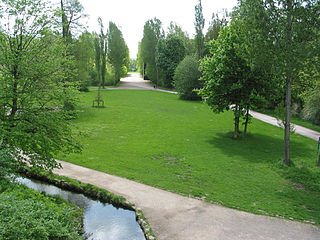Self-guided Sightseeing Tour #5 in Weimar, Germany
Legend
Guided Free Walking Tours
Book free guided walking tours in Weimar.
Guided Sightseeing Tours
Book guided sightseeing tours and activities in Weimar.
Tour Facts
3.5 km
79 m
Experience Weimar in Germany in a whole new way with our free self-guided sightseeing tour. This site not only offers you practical information and insider tips, but also a rich variety of activities and sights you shouldn't miss. Whether you love art and culture, want to explore historical sites or simply want to experience the vibrant atmosphere of a lively city - you'll find everything you need for your personal adventure here.
Individual Sights in WeimarSight 1: Johanneskirche
The Protestant St. John's Church at Tiefurter Allee 2 c in Weimar's Parkvorstadt is one of the few sacred buildings built in the 1930s. The simple hall building was built between 1938 and 1941. The design was provided by the Weimar architect Hans Vogel. At Pentecost 1941, the church was consecrated as the Duke Bernhard Church. The name was changed to Johanneskirche in 1947.
Sight 2: Ildefonso-Brunnen
Since the 17th century, the fountains in Weimar have supplied the inhabitants of the city of Weimar with water from the spring areas outside the city via an independent "tube ride system". Today, the cityscape is still characterized by about 30 historic and modern running fountains. A special curiosity are the dog fountains suggested by Theodor Lüdde, a pharmacist and animal lover. In general, there are many fountains in Weimar's old town.
Sight 3: Schillers Wohnhaus
The Schiller House Weimar is a museum operated by the Klassik Stiftung Weimar in the former home of Friedrich Schiller (1759–1805) in Weimar. In 1988, the new building of the Schiller Museum was erected behind the house, which is now used for special and temporary exhibitions of the Klassik Stiftung Weimar.
Sight 4: Deutsches Nationaltheater und Staatskapelle Weimar
The Deutsche Nationaltheater und Staatskapelle Weimar (DNT), or German National Theater and Weimar State Orchestra, is the most significant arts organization in Weimar. The institution unites the Deutsches Nationaltheater with the Staatskapelle Weimar. It plays on a total of six stages across the city. All sections of the theater and orchestra periodically give additional guest performances and appear in electronic media.
Wikipedia: Deutsches Nationaltheater und Staatskapelle Weimar (EN), Website
Sight 5: Christoph Martin Wieland
Christoph Martin Wieland was a German poet and writer, representative of literary Rococo. He is best-remembered for having written the first Bildungsroman, as well as the epic Oberon, which formed the basis for both Friederike Sophie Seyler's opera of the same name and Carl Maria von Weber's opera of the same name. His thought was representative of the cosmopolitanism of the German Enlightenment, exemplified in his remark: "Only a true cosmopolitan can be a good citizen." He was a key figure of Weimar Classicism and a collaborator of Abel Seyler's theatre company.
Sight 6: Goethe-National-Museum/Goethes Wohnhaus
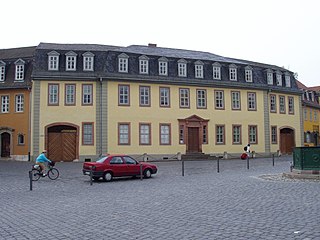
The Goethe-Nationalmuseum is a museum devoted to the German author Johann Wolfgang von Goethe, in the town of Weimar in Germany. Originally comprising the Goethe House, where Goethe lived intermittently for 50 years from 1782 to 1832, the museum was founded on 8 August 1885 as a result of the will of Goethe's last living heir, his grandson Walther von Goethe, who left the Goethe House to the state.
Sight 7: Goethes Gartenhaus
Goethe's garden house in the park on the Ilm in Weimar was a home and workplace of Johann Wolfgang von Goethe. Since 1998, it has been a UNESCO World Heritage Site as part of the "Classical Weimar" ensemble. The Corona-Schröter-Weg runs past this. It stands at the foot of the Horn.
Sight 8: Ilmpark
The Park an der Ilm is a large Landschaftspark in Weimar, Thuringia. It was created in the 18th century, influenced by Johann Wolfgang von Goethe, and has not been changed much, preserving a park of the period. It forms part of the World Heritage Site "Classical Weimar along with other sites across Weimar bearing testimony to the city's historical importance as a cultural hub during the Weimar Classicism movement in the late 18th and 19th centuries".
Share
How likely are you to recommend us?
Disclaimer Please be aware of your surroundings and do not enter private property. We are not liable for any damages that occur during the tours.
GPX-Download For navigation apps and GPS devices you can download the tour as a GPX file.
